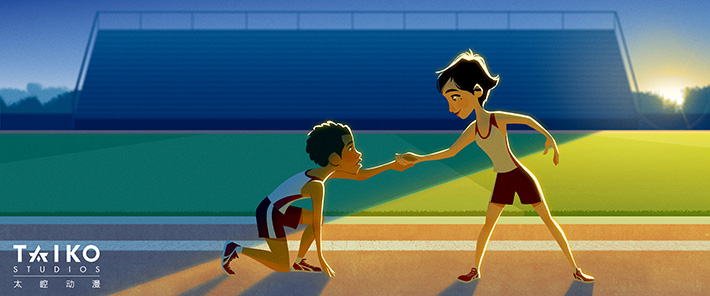
Universal Animation

One Small Step tells the story of Chinese-American girl Luna Chu pursuing her dream of becoming an astronaut. The animated short film appeals to worldwide audiences with its unique father-daughter dynamic.
The debut production of indie animation studio TAIKO, One Small Step, scored an Oscar nomination for Best Animated Short this year. When art director Bobby Pontillas found out about the nomination, he screamed at the top of his lungs and fell on the floor. Pontillas called Andrew Chesworth, head of development, and Zhang Shaofu, producer of the film, and exclaimed, “We did it! We did it! We did it!”
It took a total of 7,000 working hours to complete the seven-minute film. About 20 members of TAIKO’s production team each invested more than a year of their lives since pre-production began in January 2017. The Oscar nomination marked a huge win for the team even though the film had already been selected by more than 100 international film and animation festivals and won 34 awards of international significance.
Dreams Come True
One Small Step follows the story of Chinese-American girl Luna Chu pursuing her dream of becoming an astronaut. Watching a rocket launch on TV inspires her reach for the stars. This dream is supported by her single father who operates a shoe repair business. As Luna grows up, she faces all kinds of challenges as she pursues her dream.
During early development, the TAIKO team sat in a circle on the floor sharing personal stories about growing up and then mashed the different parenting styles together to create the father-daughter dynamic. Pontillas grew up in a single-parent family, and his mother was always there for him as he pursued his passion for art. “Our connection to the story was chasing our dreams—the dream to become an animator and make a living as an artist, which is crazy if you think about it,” he explained. “But we all developed that dream early on, and when we finally got to a place where we could say ‘Hey, I’m an animator,’ the first thing we thought about was the people who supported us along the way.”
This concept was the inspiration for the tear-jerking scene in which Luna has a flashback, right after she sets foot on the moon, of jumping into her father’s arms.
“Everyone had a different story, but we found much in common—our childhood dreams grew because we had people who cared, trusted and supported us,” Zhang noted. “There’s universality to the lives that we lead, and that translates and resonates into the stories that we’re trying to tell.”
The character Luna was based on Chinese female astronauts Liu Yang and Wang Yaping.
“Traveling into space has been one of the hardest dreams for mankind to reach,” Zhang added. “We spent a lot of time researching the efforts astronauts make and the challenges they conquer. In Liu and Wang we saw earnestness and resilience.”




Stills from the Oscar nominee One Small Step. The soft painted style of its characters gives the 3D animated film a unique look.
Los Angeles Meets Wuhan
In the film, the NASA recruitment letter received by Luna is addressed to San Francisco, and next door to her house is a restaurant selling hot dry noodles, a popular snack in Wuhan, central China. This is one of the Easter eggs.
Zhang Shaofu was born in Wuhan. At the age of five, he moved to the United States with his family. After graduating from the Academy of Art in San Francisco, he worked with Sony Pictures Imageworks and Walt Disney Animation Studios, contributing to several blockbusters as a character animator.
“I always dreamed about starting my own studio and doing something different—breaking out of the shell of the studio system,” Zhang admitted. Zhang’s passion resonated with Chesworth and Pontillas, who had worked closely with Zhang on Big Hero 6, Zootopia and Moana.
Feeling the winds blowing in favor of animation during a trip to China, Zhang became determined to found a studio in his hometown Wuhan, Hubei Province, alongside another in Burbank.
“China’s animation industry is young but maturing,” Zhang beamed, listing standouts such as Monkey King: Hero Is Back and White Snake. “Wuhan has a lot of animation graduates ready to work. Production is more cost-effective there.”
TAIKO’s Burbank branch is staffed with over 10 members mainly working on core creation. Its Wuhan team with over 30 members, mostly veterans, focuses more on detailed production.
Upholding the “less is more” principle, TAIKO animators utilized many different programs to achieve the “moving illustration” effect in One Small Step. They didn’t want the film to have a 3D model effect even though it was 3D animated. Combined with the soft painted style of the characters, the film has a unique look.
No dialogue happens in the film. Instead, the team opted to capture emotional changes with exquisite design. For instance, close-ups on Luna’s feet let her walking reflect her changing mood with the ups and downs in personal growth. Even the direction in which she moves gives clues. When Luna walks from left to right, it usually signals positive events are about to happen. When she walks the other way, negative things follow.
Color and music both play big roles in the film. “Knowing what color to use and when to add music and take it away really adds another layer of emotion to the story,” Chesworth remarked. The blue and white light on Luna implies hope, and orange on her father matches his warm, tolerant and supportive personality. Light and joyful piano represents Luna, and a peaceful cello her father.
“Understanding how the little intricacies can affect the mood helps convey the story you want to tell,” Chesworth explained.

A video meeting between TAIKO Studios’ two teams in Beijing and Burbank. The two teams video-chatted twice a week throughout the production of One Small Step. The meetings enabled Chinese and American animators to raise questions and respond efficiently.
Extensive discussion between TAIKO’s two offices continued throughout production. They video-chatted twice a week, usually in the morning Beijing time, before the Los Angeles team went home and after the Wuhan team had started. This relay routine enabled animators to raise questions and respond efficiently. Emails assisted the work with recorded explanatory videos as well as pictures and files with revision advice.“The distance did not prevent the two offices from direct and smooth communication,” Zhang said.
Zhang sees TAIKO as a truly international studio capable of producing animation to bridge cultural gaps and capture both Chinese and American values.
“I think there’s a misconception, or maybe a preconception, that Chinese culture is very different from American culture, but it’s really not.”